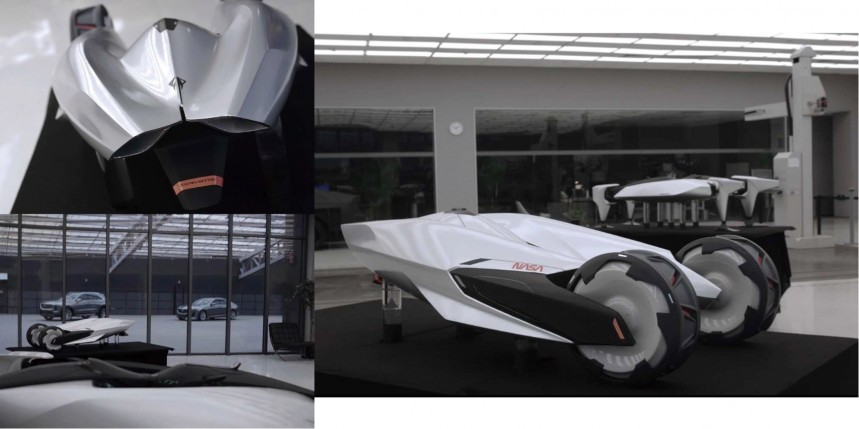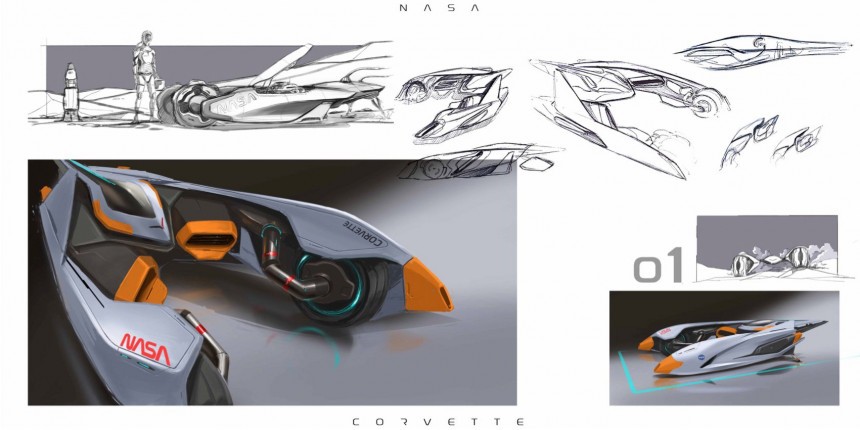Everybody loves a Chevy, whether it’s a pick-up, SUV, or a Corvette. It doesn’t matter much since the name and sigil say it all. But what happens when NASA joins in the fun?
What happens? This happens. Believe it or not, we’re looking at a possible design for the 2040 ‘Vette. But that would be a bit of a stretch as Chevy probably doesn’t even know what the Corvette might look like in five years, let alone 20.
What we are seeing is a design by Han Yu from Xi’an, China, that is actually destined to be raced on Mars. And yes, it is considered a Corvette, but only because of the sigil, as the lines on this concept have very little to do with the actual Corvette.
And even if this is a bit of a stretch, it doesn’t really matter, as these designs are very good at getting us dreaming. And this dream is a complex one, but hella cool, so let’s break down what we see.
The design looks more like a pod racer from the movie Star Wars, but unlike pod racers, the front of the vehicle still includes wheels. Before we get into the maneuvering aspect of this design, we’ve got to let you know that it’s actually a vehicle composed of many separate hardware. There are two-wheel systems, two jet propulsion systems, two side panels to house them, a chassis, and one pilot pod.
All are supposed to go together as follows; the side panels include the wheel system at the front, and jet propulsion at the back. Once connected, each side panel then connects to the chassis. Then, after system checks are completed, the pilot or racer pod is linked to the entire thing. Once it’s all connected, it ends up looking like this. Come to think of it, it does have a vague resemblance to a ‘Vette, with the lifted rear and all, but that’s it.
One thing I did enjoy about this design is that it includes propulsion that still burns things. That's because it shows jet propulsion at the rear (this component also acts to hold the rear of the vehicle off the ground as we have no wheels here), and I don’t know about any jets being powered by batteries or solar energy.
The only wheels are those at the front, which also allow the ride to turn on a dime if needed. It’s basically a jet-propelled wheelbarrow for the unforgiving terrain on Mars.
But what about the actual racing? Well, we’re told there are two ways to do it. Either getting in the ride and flying around on off-world racetracks, or piloting it via a mind-control system. But not one where your mind is controlled, but one where your mind does the controlling. Basically, remote operation from the comfort of your home base. And it’s all because of a chip implanted in your brain.
Now it all does seem a bit farfetched, but with the way tech is currently advancing, I think we could be seeing VR sets that do this sort of thing quite soon. Maybe just not for racing on Mars.
What we are seeing is a design by Han Yu from Xi’an, China, that is actually destined to be raced on Mars. And yes, it is considered a Corvette, but only because of the sigil, as the lines on this concept have very little to do with the actual Corvette.
And even if this is a bit of a stretch, it doesn’t really matter, as these designs are very good at getting us dreaming. And this dream is a complex one, but hella cool, so let’s break down what we see.
All are supposed to go together as follows; the side panels include the wheel system at the front, and jet propulsion at the back. Once connected, each side panel then connects to the chassis. Then, after system checks are completed, the pilot or racer pod is linked to the entire thing. Once it’s all connected, it ends up looking like this. Come to think of it, it does have a vague resemblance to a ‘Vette, with the lifted rear and all, but that’s it.
One thing I did enjoy about this design is that it includes propulsion that still burns things. That's because it shows jet propulsion at the rear (this component also acts to hold the rear of the vehicle off the ground as we have no wheels here), and I don’t know about any jets being powered by batteries or solar energy.
But what about the actual racing? Well, we’re told there are two ways to do it. Either getting in the ride and flying around on off-world racetracks, or piloting it via a mind-control system. But not one where your mind is controlled, but one where your mind does the controlling. Basically, remote operation from the comfort of your home base. And it’s all because of a chip implanted in your brain.
Now it all does seem a bit farfetched, but with the way tech is currently advancing, I think we could be seeing VR sets that do this sort of thing quite soon. Maybe just not for racing on Mars.














